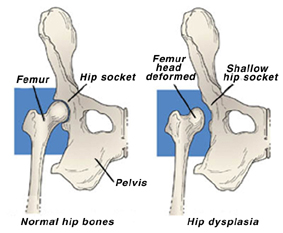
Canine hip dysplasia (abnormal development of the hip joint) begins when the hip joint in a young dog becomes loose or unstable. If left undiagnosed and untreated, this instability causes abnormal wear of the hip cartilage and ultimately progresses to osteoarthritis or degenerative joint disease. Signs of this condition are pain, reluctance to get up or exercise, difficulty climbing stairs, a “bunny-hopping” gait, limping, and lameness, especially after periods of inactivity or exercise.
Hip dysplasia most commonly affects large- and giant-breed dogs; however, smaller dogs can also be affected. Although genetics often play a role in this disorder, young dogs that grow or gain weight too quickly or get too much high-impact exercise are also at risk. Being overweight can aggravate hip dysplasia.
Elbow dysplasia is another painful condition of one or both elbows. It’s thought to have both genetic and environmental contributors.
We can help manage these conditions by monitoring body condition, fitness level, and ensuring that your dog gets proper exercise as he or she ages. We can also screen your dog for hip and elbow dysplasia via OFA. The earlier we can diagnose hip dysplasia, the better the possible outcome for your dog. This information is also extremely valuable to breeders as a part of comprehensive health screening. Please click here for more information about OFA Certification.
Please call us to discuss your dog’s risk of developing hip dysplasia, to schedule a screening, or to discuss treatment options.
